-
Happy First Circulation of Canadian Coins (1858)! 🇨🇦 🪙
You are using an out of date browser. It may not display this or other websites correctly.
You should upgrade or use an alternative browser.
You should upgrade or use an alternative browser.
South Saskatchewan River in Alberta
- Thread starter PaddlingPitt
- Start date
- Joined
- Aug 21, 2018
- Messages
- 1,805
- Reaction score
- 2,219
I was thinking of a similar trip on the Assiniboine
First of all, let me say that I am sorry to hear about your medical problems. Good to see that you remain undeterred, though.
You certainly know more about the Assiniboine than I do. Preeceville, where I live, refers to itself as the headwaters of the Assiniboine. Even at or near spring flood, there’s not enough to teach basic moving water skills, which we used to do in Vancouver, to people have never been on moving water. Between here and Yorkton, 100 km by road, we cross the Assiniboine several times. Pretty much just a slough, and very unappealing.
But the Assiniboine is a very long river. It must get better. I found several references on the internet about paddling from Brandon to Winnipeg. Bothwell Voyaguer (spelling?) from this site has posted information on myccr.ca under his real name. You likely know him.
- Joined
- Aug 21, 2018
- Messages
- 1,805
- Reaction score
- 2,219
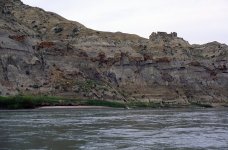
These "Bad Lands” were created by more resistant rocks capping the softer sandstones.
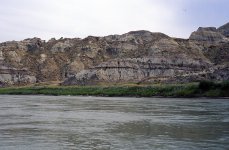
This was a very pleasant part of the trip through canyons in the Suffield Military Reserve. No road access adds to the feeling of wilderness travel. Help can be a day, or more away. Even though an easy river, paddlers must still be self-reliant.
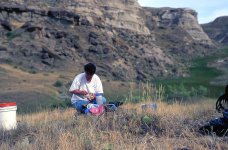
We brought our MSR MiniWorks filter because of so many cows along the river. A book that we bought after the trip says that the water should not be drunk at all. We suffered no problems with our filtered water, though.
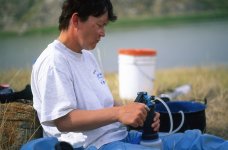
We could filter one litre of water in 1 minute. Too only 10 minutes to fill up our ten-litre container. It turns out that we could have easily filled our containers along the way, such as in Medicine Hat. But we were not certain of that possibility before the trip. Best to be self-reliant throughout.
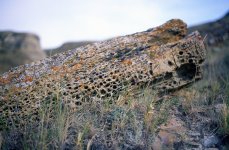
Even a single rock can provide a miniature “Bad Lands.”
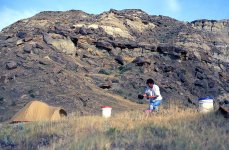
There were no bears or difficult rapids on this trip. But Kathleen said we had to worry about something, and that was rattle snakes. We didn’t see any rattle snakes on the trip, though.

We carried all our gear to camp every night. I have developed tripping habits on my previous extended canoe trips, and one of them is to be surrounded by all my gear in camp. I like to keep a watchful eye on my stuff.
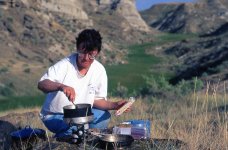
We packed way too much food for this easy, warm trip. We usually just had soup for supper.
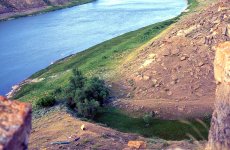
The long, gentle coulees offered easy hikes to the scenic high ground above our camp.
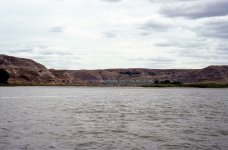
Approaching highway 41 bridge and Sandy Point Camp ground, 4.5 days and 168 km (104 miles) downstream of Medicine Hat. This stretch from Medicine Hat to Sandy Point would make an excellent shorter family trip. I don't know what that white line across to river is. Probably just an imperfection in the scanned slide.
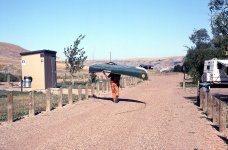
I'm not really portaging to the outhouse. I just like to be surrounded by my stuff at night, and am bringing our canoe to camp.
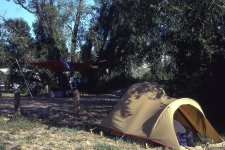
Camping fee was only $5.00 CAN per night.
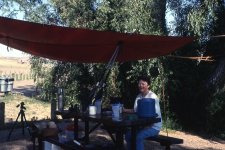
We enjoyed tables and running water. An easy take-out here, and the camp attendant indicated that paddlers often leave their vehicle here, where it is safe from vandalism.
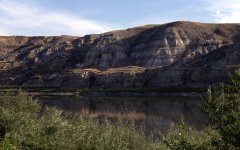
View from Sandy Point Campground.
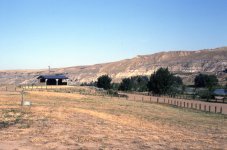
The caretaker at the Sandy Point Camproung said that she counted her blessings that she was able to spend her summer here.
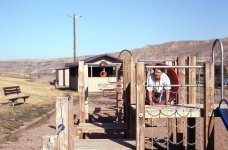
Kids will be kids - another playground.
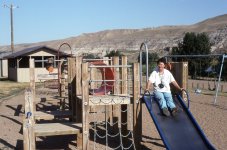
No waiting in line at the slide.
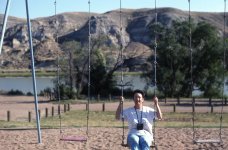
We didn't expect swings when we were planning our trip on the South Saskatchewan River.
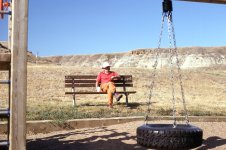
But we can't play all day. We gotta get back on the river. Remember, we are on our way to the Family Reunion.
Last edited:
What a great trip! I was wondering about water quality with all the farms along the river. One of the rivers I used to paddle in Nova Scotia ran through farming land for many miles, and was eventually declared unfit for any water activities. Run off from intensive animal farming, pesticides and fertilizer had apparently turned the river into a chemical cesspit. Was it a similar situation for the SS?
Saskatchewan, where you measure distance in hours, where it's so flat that if you look carefully off into the distance you can just see the back of your head...and if your gear blows away you can watch it go for 2 days.
Tell Kathleen I'm just kidding. That province has always been on my visiting wish list. Funny how whenever I mention this to folks who've driven through on the TransCanada I am told how boring and flat it is and I should just get through it on the way to somewhere more interesting as fast as I can. I then ask these same people what it's like to go through life with blinders on. Sheesh.
Anyway, thanks Mike & Kath for this visit to another beautiful river. One with playgrounds!
Tell Kathleen I'm just kidding. That province has always been on my visiting wish list. Funny how whenever I mention this to folks who've driven through on the TransCanada I am told how boring and flat it is and I should just get through it on the way to somewhere more interesting as fast as I can. I then ask these same people what it's like to go through life with blinders on. Sheesh.
Anyway, thanks Mike & Kath for this visit to another beautiful river. One with playgrounds!
- Joined
- Aug 21, 2018
- Messages
- 1,805
- Reaction score
- 2,219
What a great trip! I was wondering about water quality with all the farms along the river. One of the rivers I used to paddle in Nova Scotia ran through farming land for many miles, and was eventually declared unfit for any water activities. Run off from intensive animal farming, pesticides and fertilizer had apparently turned the river into a chemical cesspit. Was it a similar situation for the SS?
Mem, I sort of remember the river being generally clear and fresh looking. If not for the cows, I probably would have drank the water without filtering. I might be misremembering, though. There was that book that suggested not drinking the water, even if filtered.
Last edited:
- Joined
- Aug 21, 2018
- Messages
- 1,805
- Reaction score
- 2,219
Saskatchewan, where you measure distance in hours, where it's so flat that if you look carefully off into the distance you can just see the back of your head...and if your gear blows away you can watch it go for 2 days.
Tell Kathleen I'm just kidding. That province has always been on my visiting wish list. Funny how whenever I mention this to folks who've driven through on the TransCanada I am told how boring and flat it is and I should just get through it on the way to somewhere more interesting as fast as I can. I then ask these same people what it's like to go through life with blinders on. Sheesh.
Anyway, thanks Mike & Kath for this visit to another beautiful river. One with playgrounds!
Odyssey,
To be clear, the images in this TR are in Alberta, not Saskatchewan. I happen to like grasslands, and in fact, was a grassland ecologist. Perhaps those people who consider Saskatchewan boring have not yet learned to enjoy grasslands. And, not trying to be critical, I have seen lots of aerial images of the boreal forest, including in Ontario, where the landscape is flat. It's not exactly mountains like BC or the Yukon. One could consider flat, boreal forest to be boring. I should also point out that although Saskatchewan is called a Prairie Province, 60% of Saskatchewan is boreal forest, just like Ontario. If the Trans Canada went through northern Saskatchewan, you friends would likely have a much different opinion.
On the other hand, after the Family Reunion, I remarked to Kathleen how, "I could never live in Saskatchewan. Way too many roads." Apparently one should never say never. I have now lived in Saskatchewan for just under 11 years.
"To be clear, the images in this TR are in Alberta, not Saskatchewan." My ooops!
No need to defend landscapes to me Michael. I haven't seen a horizon I didn't like.
No need to defend landscapes to me Michael. I haven't seen a horizon I didn't like.
- Joined
- Aug 21, 2018
- Messages
- 1,805
- Reaction score
- 2,219
Odyssey,
You’re like the Will Rogers of horizon admirers! Will apparently said that he never met a man he didn’t like.
You’re like the Will Rogers of horizon admirers! Will apparently said that he never met a man he didn’t like.
I too wondered about the water quality after seeing the cows along the banks. Having been a pond swimmer and skater in my youth I can attest to the fact that where cows go cow pats follow. Although they make okay goal posts in winter (when fully frozen) they make swimming holes that much less desirable. And when picking apples from trees in cow pastures be careful tossing the picked fruit down. Aim carefully. And do this quickly as the curious beasts will invariably wander over to snack on your hoard of Russets. The only good thing about the cow pastures are their salt licks. A healthy spit and polish with a shirt sleeve and ya have a salty rub for your apples. Tasty. At least it was when I was 11. In summer I'd only swim in cow-free ponds. I might've been a hayseed but I wasn't stupid. Cow ponds were for boating. Crudely constructing battleships out of 2x4s in Dad's workshop and sailing them across the pond. But if a breeze came up and pushed the fleet off course and left them floundering on suspicious looking reefs I didn't dare wade in to rescue the crews. Those I considered "lost at sea". Lots of scrap 2x4s left in the shed. Okay, sorry for the OT blab.
The H2O filter was a good investment I think. What kind of meals were you eating may I ask? Just curious.
The H2O filter was a good investment I think. What kind of meals were you eating may I ask? Just curious.
Last edited:
- Joined
- Aug 21, 2018
- Messages
- 1,805
- Reaction score
- 2,219
Odyssey,
Our meals are simple and easy to prepare. We have bannock, with margarine and jam, every morning for breakfast. Unless, for some reason, we are in a hurry to pack up and leave. Then we have a granola bar. At breakfast, we also heat water to put into a thermos, for our Top Ramen soup at lunch, prepared in our tea mugs. We also have crackers, peanut butter, cheese, maybe some salami, and dried fruit with the soup. For supper we have things like Shepherd's pie, turkey cabbage soup, chilli and spaghetti. Kathleen dehydrates all our suppers. All our suppers are one-pot affairs. No side dishes. No several-course meals. Easy to heat up. Easy to clean up. We also take along a home-made fruit cake for the occasional bedtime snack. Fruit cake keeps very well.
Anyway, back to the story!
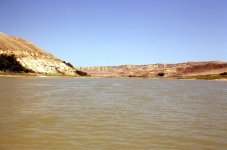
Looking east, toward Saskatchewan.

We are now in Saskatchewan, at the confluence with the Red Deer River, which I am told also makes a nice prairie canoe trip.
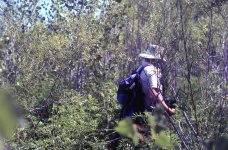
Searching for a camp on an overgrown island. These searches were usually hard, hot work, which often required an hour or more at the end of the day.
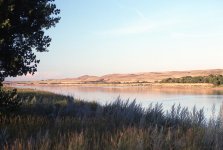 View downstream from our camp below the confluence of the Red Deer River. We are only 6 km (3.5 miles) from the Estuary Ferry, but Kathleen's sister Marilyn will not be there for two more days. This gave us time to relax with our first rest day of the trip.
View downstream from our camp below the confluence of the Red Deer River. We are only 6 km (3.5 miles) from the Estuary Ferry, but Kathleen's sister Marilyn will not be there for two more days. This gave us time to relax with our first rest day of the trip.
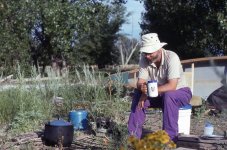
The next morning we slept until the sun touched our faces, and we enjoyed our morning campfire with bannock for breakfast, with lingering cups of tea. We no longer take that big pot, which we used when we went with other couples on the South Nahanni and on the Coppermine Rivers. Much bigger, though, than the two of us actually need. We now take only our set of nesting pots left over from our backpacking days. We normally don't take that 10 litre water jug either. We did for this trip because we were filtering and storing water.
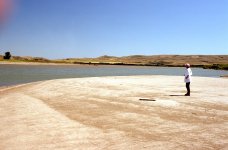
We explored our island, and enjoyed our lunch on a sandbar. Also kind of entertaining to watch the cows on the opposite bank.
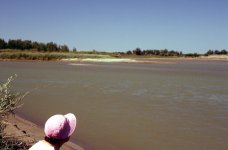
Still at the confluence of the Red Deer River. Just below here, on the shore opposite our island camp, Peter Fidler of the Hudson Bay Company established Chesterfield House in September of 1800. Its history was brief, however, as the company traded furs with the First Nation's people for only two years at this spot.
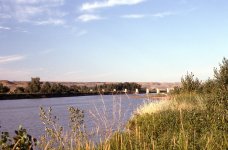
Abandoned towers of the Canadian Pacific Railway. A CPR survey party camped here in 1881 reported that the party’s horses became deeply mired, but were pulled clear with ropes.
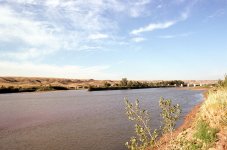
The surveyor reported that in September 1881, the river was low, leaving large stretches of quicksand. Later that fall, a North West Mounted Police party camped in the same area. A policemen going for water became mired and drowned.
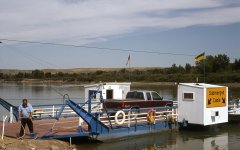
We also found the river to be shallow and sandy, with no clear channel, but reached the Estuary Ferry in a little under two hours of paddling.
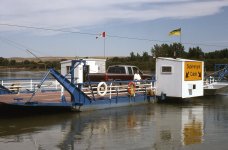
This "demand ferry" is part of the highway system, and provided more "playground" entertainment for Kathleen - riding the ferry while waiting for her sister Marilyn.
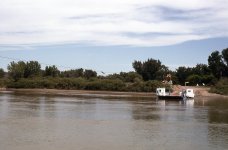
Back and forth. The ferry operator seemed lonely, and was glad for the company. We shared our knot knowledge. I taught him the truckers hitch, and he taught me the "figure of 8," or Cleat Hitch for tying ropes to the horn on the dock. He could do it with one hand, without even bending over, while standing a fair distance away.
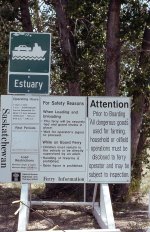
Marilyn and her family finally arrived, and we were off to the Family Reunion near Knistino, Saskatchewan.
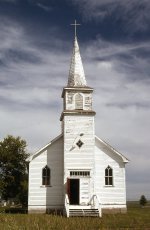
Kathleen was born in British Columbia, and grew up in Vancouver. Her mother Teresa was from Saskatchewan, but moved to Victoria after graduating from the University of Saskatchewan, to accept a position as a Dietician. It was in Victoria that she met her husband, Joseph. Joe & Terry, and the family often spent summer holidays at the family farm in Saskatchewan. Kathleen enjoyed seeing cousins she hadn’t seen in 15 years. We revisited family sites like the Fishing Lake Church that her grandfather built, and where he is buried. I’m glad Kathleen seduced me to canoe to the Family Reunion on the South Saskatchewan River.
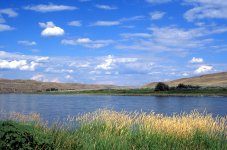
It was a relaxing trip with plenty of time for lazy naps beneath the warm afternoon sun.
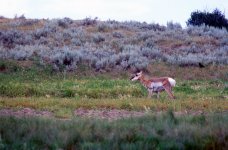
We saw wildlife, including pronghorn (antelope), snakes and pelicans After the sun set, we listened nightly to the yipping and howling of coyotes.
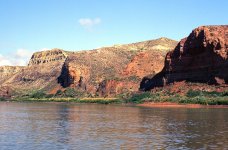
We mostly just floated through beautiful canyons. Throughout the 11 days on the trip, we never paddled more than six hours.
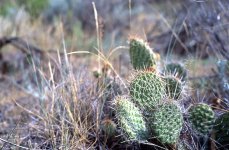
This gave us plenty of time to enjoy the almost desert-like vegetation,
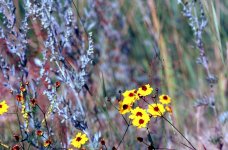
Growing alongside vibrant prairie wild flowers.
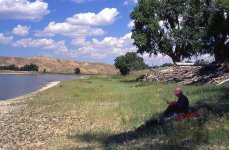
I believe that this section of the South Saskatchewan River would make an excellent family trip. Lunches beneath the shade of old cottonwood trees, where children would have time and room to run, roam or just relax.
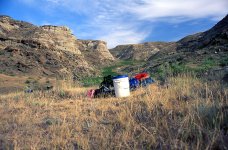
The weather on the South Saskatchewan River is generally dry, the sky is nearly always blue, and the scenery throughout is gentle and inviting.
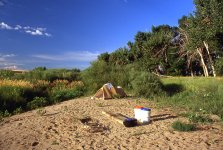
We always were able to find plenty of wood for dinner and breakfast campfires. We still have that purple towel. We still have those same two white buckets. One is for soon-to-be-eaten food. The other is our kitchen bucket, or "wannigan," if you prefer.
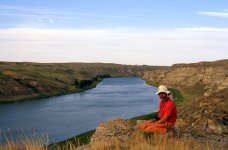
The short paddling days, combined with extended evenings provided time to contemplate the next bend in the river, and to dream of the many vistas that wait for us on wilderness canoe trips still to be paddled. Hard to imagine very many activities more satisfying than just floating down the river. Or as the Water Rat said to the Mole in Wind in the Willows, "Believe me, my young friend, there is nothing - absolutely nothing-half so much worth doing as simply messing about in boats."
(I still have, and use, that same red t-shirt, bought in 1981. It is starting to get a bit threadbare. I wore it on the Yukon River this past summer (2019) though. Still working on fleshing out my diary of the Yukon trip. It will be a while still, I think.)
Our meals are simple and easy to prepare. We have bannock, with margarine and jam, every morning for breakfast. Unless, for some reason, we are in a hurry to pack up and leave. Then we have a granola bar. At breakfast, we also heat water to put into a thermos, for our Top Ramen soup at lunch, prepared in our tea mugs. We also have crackers, peanut butter, cheese, maybe some salami, and dried fruit with the soup. For supper we have things like Shepherd's pie, turkey cabbage soup, chilli and spaghetti. Kathleen dehydrates all our suppers. All our suppers are one-pot affairs. No side dishes. No several-course meals. Easy to heat up. Easy to clean up. We also take along a home-made fruit cake for the occasional bedtime snack. Fruit cake keeps very well.
Anyway, back to the story!

Looking east, toward Saskatchewan.

We are now in Saskatchewan, at the confluence with the Red Deer River, which I am told also makes a nice prairie canoe trip.

Searching for a camp on an overgrown island. These searches were usually hard, hot work, which often required an hour or more at the end of the day.
 View downstream from our camp below the confluence of the Red Deer River. We are only 6 km (3.5 miles) from the Estuary Ferry, but Kathleen's sister Marilyn will not be there for two more days. This gave us time to relax with our first rest day of the trip.
View downstream from our camp below the confluence of the Red Deer River. We are only 6 km (3.5 miles) from the Estuary Ferry, but Kathleen's sister Marilyn will not be there for two more days. This gave us time to relax with our first rest day of the trip.
The next morning we slept until the sun touched our faces, and we enjoyed our morning campfire with bannock for breakfast, with lingering cups of tea. We no longer take that big pot, which we used when we went with other couples on the South Nahanni and on the Coppermine Rivers. Much bigger, though, than the two of us actually need. We now take only our set of nesting pots left over from our backpacking days. We normally don't take that 10 litre water jug either. We did for this trip because we were filtering and storing water.

We explored our island, and enjoyed our lunch on a sandbar. Also kind of entertaining to watch the cows on the opposite bank.

Still at the confluence of the Red Deer River. Just below here, on the shore opposite our island camp, Peter Fidler of the Hudson Bay Company established Chesterfield House in September of 1800. Its history was brief, however, as the company traded furs with the First Nation's people for only two years at this spot.

Abandoned towers of the Canadian Pacific Railway. A CPR survey party camped here in 1881 reported that the party’s horses became deeply mired, but were pulled clear with ropes.

The surveyor reported that in September 1881, the river was low, leaving large stretches of quicksand. Later that fall, a North West Mounted Police party camped in the same area. A policemen going for water became mired and drowned.

We also found the river to be shallow and sandy, with no clear channel, but reached the Estuary Ferry in a little under two hours of paddling.

This "demand ferry" is part of the highway system, and provided more "playground" entertainment for Kathleen - riding the ferry while waiting for her sister Marilyn.

Back and forth. The ferry operator seemed lonely, and was glad for the company. We shared our knot knowledge. I taught him the truckers hitch, and he taught me the "figure of 8," or Cleat Hitch for tying ropes to the horn on the dock. He could do it with one hand, without even bending over, while standing a fair distance away.

Marilyn and her family finally arrived, and we were off to the Family Reunion near Knistino, Saskatchewan.

Kathleen was born in British Columbia, and grew up in Vancouver. Her mother Teresa was from Saskatchewan, but moved to Victoria after graduating from the University of Saskatchewan, to accept a position as a Dietician. It was in Victoria that she met her husband, Joseph. Joe & Terry, and the family often spent summer holidays at the family farm in Saskatchewan. Kathleen enjoyed seeing cousins she hadn’t seen in 15 years. We revisited family sites like the Fishing Lake Church that her grandfather built, and where he is buried. I’m glad Kathleen seduced me to canoe to the Family Reunion on the South Saskatchewan River.

It was a relaxing trip with plenty of time for lazy naps beneath the warm afternoon sun.

We saw wildlife, including pronghorn (antelope), snakes and pelicans After the sun set, we listened nightly to the yipping and howling of coyotes.

We mostly just floated through beautiful canyons. Throughout the 11 days on the trip, we never paddled more than six hours.

This gave us plenty of time to enjoy the almost desert-like vegetation,

Growing alongside vibrant prairie wild flowers.

I believe that this section of the South Saskatchewan River would make an excellent family trip. Lunches beneath the shade of old cottonwood trees, where children would have time and room to run, roam or just relax.

The weather on the South Saskatchewan River is generally dry, the sky is nearly always blue, and the scenery throughout is gentle and inviting.

We always were able to find plenty of wood for dinner and breakfast campfires. We still have that purple towel. We still have those same two white buckets. One is for soon-to-be-eaten food. The other is our kitchen bucket, or "wannigan," if you prefer.

The short paddling days, combined with extended evenings provided time to contemplate the next bend in the river, and to dream of the many vistas that wait for us on wilderness canoe trips still to be paddled. Hard to imagine very many activities more satisfying than just floating down the river. Or as the Water Rat said to the Mole in Wind in the Willows, "Believe me, my young friend, there is nothing - absolutely nothing-half so much worth doing as simply messing about in boats."
(I still have, and use, that same red t-shirt, bought in 1981. It is starting to get a bit threadbare. I wore it on the Yukon River this past summer (2019) though. Still working on fleshing out my diary of the Yukon trip. It will be a while still, I think.)
Last edited:
I really enjoyed this trip report ! The photography, as well as comments, make this a tempting trip !
I've noted over the years, that compatibility can be tested in a tandem canoe ! You two have obviously passed the test !
Thanks !
Glad to know also, I'm not the only paddler that hasn't gone to blue barrels !
I use an old USA Nylon Duffle bag, (two 5 gal pails stacked). And yes one for food, the other for mostly a cook kit.
Jim
I've noted over the years, that compatibility can be tested in a tandem canoe ! You two have obviously passed the test !
Thanks !
Glad to know also, I'm not the only paddler that hasn't gone to blue barrels !
I use an old USA Nylon Duffle bag, (two 5 gal pails stacked). And yes one for food, the other for mostly a cook kit.
Jim
Thanks for that trip report, very interesting as always.
I like how you get your moneys worth out of clothes and stuff. Like those pants you found, I found a nice pair of sandals on a sandbar once, at first I thought I shouldn't wear others footwear but they fit so good and my feet have seen some pretty rough usage so why not. Only pair of sandals I ever had.
Looking forward to your next report.
I like how you get your moneys worth out of clothes and stuff. Like those pants you found, I found a nice pair of sandals on a sandbar once, at first I thought I shouldn't wear others footwear but they fit so good and my feet have seen some pretty rough usage so why not. Only pair of sandals I ever had.
Looking forward to your next report.
What a fun idea for a "road trip", paddling to a family gathering! I really enjoyed this, thanks Michael.
ps
Here is a link to some interesting reading. http://seawa.ca/our-watershed/north-south-sask-river-basins/
ps
Here is a link to some interesting reading. http://seawa.ca/our-watershed/north-south-sask-river-basins/
Pitt, thanks for another interesting TR. You take great pictures.
- Joined
- Jan 7, 2016
- Messages
- 960
- Reaction score
- 920
Very enjoyable, well told trip down one of Canada's storied rivers, thank you.
Can not believe you are married to Mother Teresa's Daughter, but it is true.
Can not believe you are married to Mother Teresa's Daughter, but it is true.
- Joined
- Aug 21, 2018
- Messages
- 1,805
- Reaction score
- 2,219
I have appreciated all the feed back, and will respond to all below.
From Jim Dodd:
"I've noted over the years, that compatibility can be tested in a tandem canoe ! You two have obviously passed the test !
Thanks !
Kathleen and I have paddled together for a long time Jim. We have pretty much the same approach to canoeing, particularly when running rapids. I don't think we've criticized one another's paddling since maybe 1989. That's a long time.
Glad to know also, I'm not the only paddler that hasn't gone to blue barrels !
I use an old USA Nylon Duffle bag, (two 5 gal pails stacked). And yes one for food, the other for mostly a cook kit."
Kathleen and I have been very reluctant to change our gear, because it has worked for us. Always said that we preferred canvass packs because they can squash down in the boat, and get smaller as food disappears. That's why we never wanted a blue barrel. In 2017, just before our Great Slave Lake trip, one of our canvass packs finally wore out. We bought a 60 litre blue barrel. It doesn't squash down, but it is more convenient to store and find items. Don't tell anyone, but we actually like it.
From Laura P:
Thanks for that. I love a prairie river!!
You might want to consider paddling the Milk River in Southern Alberta, very near the U.S. border. Buhrmann & Young, in their book 'Canoeing Chinook Country Rivers,' indicates that "the 185 miles of its journey is through the most remote and beautiful prairielands in Southern Alberta.
From Odyssey:
Here is a link to some interesting reading. http://seawa.ca/our-watershed/north-...-river-basins/
That was interesting. Thanks for finding and posting.
From Sweetfancymoses:
Thanks for another interesting TR. You take great pictures.
It's often the subject that makes great pictures. And, if you snap enough pictures, you're bound to get a subset that are good enough to share. I should also point out that Kathleen took most of these pictures. She's more patient than I am. Probably comes from being the daughter of Mother Teresa.
-------------------------------------------------------------------------------------------------------------------------------------------------
A question for you, Robin. How did you know that the owner of those sandals wasn't coming back for them?
From Jim Dodd:
"I've noted over the years, that compatibility can be tested in a tandem canoe ! You two have obviously passed the test !
Thanks !
Kathleen and I have paddled together for a long time Jim. We have pretty much the same approach to canoeing, particularly when running rapids. I don't think we've criticized one another's paddling since maybe 1989. That's a long time.
Glad to know also, I'm not the only paddler that hasn't gone to blue barrels !
I use an old USA Nylon Duffle bag, (two 5 gal pails stacked). And yes one for food, the other for mostly a cook kit."
Kathleen and I have been very reluctant to change our gear, because it has worked for us. Always said that we preferred canvass packs because they can squash down in the boat, and get smaller as food disappears. That's why we never wanted a blue barrel. In 2017, just before our Great Slave Lake trip, one of our canvass packs finally wore out. We bought a 60 litre blue barrel. It doesn't squash down, but it is more convenient to store and find items. Don't tell anyone, but we actually like it.
From Laura P:
Thanks for that. I love a prairie river!!
You might want to consider paddling the Milk River in Southern Alberta, very near the U.S. border. Buhrmann & Young, in their book 'Canoeing Chinook Country Rivers,' indicates that "the 185 miles of its journey is through the most remote and beautiful prairielands in Southern Alberta.
From Odyssey:
Here is a link to some interesting reading. http://seawa.ca/our-watershed/north-...-river-basins/
That was interesting. Thanks for finding and posting.
From Sweetfancymoses:
Thanks for another interesting TR. You take great pictures.
It's often the subject that makes great pictures. And, if you snap enough pictures, you're bound to get a subset that are good enough to share. I should also point out that Kathleen took most of these pictures. She's more patient than I am. Probably comes from being the daughter of Mother Teresa.
-------------------------------------------------------------------------------------------------------------------------------------------------
A question for you, Robin. How did you know that the owner of those sandals wasn't coming back for them?
"A question for you, Robin. How did you know that the owner of those sandals wasn't coming back for them?"
Good one. I found them on a sandbar on a lake in NY's ADK's, Lows Lake, a very popular paddle in only destination. There was only one other car there when I put in. After I found the sandals I paddled past the only occupied campsite and struck up a conversation with the folks there....
Me: "Hi, hows the bugs been?"
Camper 1: "Not bad"
Me: Nice canoe, Swift Dumoine?"
Camper 2: "Yes, Swift Dumoine"
Me:" Any bears"
Camper 1: "No bears"
Camper 2: " We keep a clean campsite"
Me: "OK, well have a good one, I'm heading up the lake a ways'"
Camper 1 "Bye"
Camper 2 "Bye"
Me: "See ya....oh, by the way, what size shoes do you boys where.
HaHa
Good one. I found them on a sandbar on a lake in NY's ADK's, Lows Lake, a very popular paddle in only destination. There was only one other car there when I put in. After I found the sandals I paddled past the only occupied campsite and struck up a conversation with the folks there....
Me: "Hi, hows the bugs been?"
Camper 1: "Not bad"
Me: Nice canoe, Swift Dumoine?"
Camper 2: "Yes, Swift Dumoine"
Me:" Any bears"
Camper 1: "No bears"
Camper 2: " We keep a clean campsite"
Me: "OK, well have a good one, I'm heading up the lake a ways'"
Camper 1 "Bye"
Camper 2 "Bye"
Me: "See ya....oh, by the way, what size shoes do you boys where.
HaHa
Great write up Michael! The landscape is so different than your other trip reports and I, being ignorant, was astounded at all the flatness, cactus, bluffs! Once again thank you for sharing another one of yours and Kathleen's journeys! BTW, one hell of a way to go to a family reunion!
dougd
dougd
Similar threads
- Replies
- 31
- Views
- 1K
- Replies
- 9
- Views
- 2K
